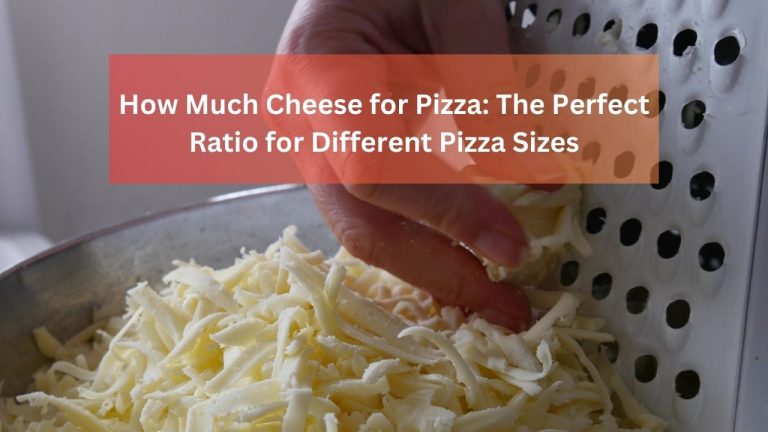10-Inch Pizza Weight – How To Decrease And Increase It
Do you know how much a 10-inch pizza weight? Chances are, when it comes to feeding your family, ordering takeout, or serving a special meal to guests, the weight of a pizza isn’t something that crosses your mind.
But if you’re looking for an easy way to estimate portion size and compare different types of crusts and ingredients, knowing the approximate weight of a 10-inch pizza can be extremely helpful! In this blog post, we’ll explore the factors that impact the weight of 10-inch pizzas so you can make informed decisions when selecting all aspects of your perfect pie.
Tabel for Famous Pizza weights
Here’s the table for famous pizza types and their weight in 1 slice
| Pizza Type | Weight per Slice | Serving |
|---|---|---|
| Calzone | 364 g | 1 calzone (364 g) |
| Beef Pizza | 235 g | 1 slice (235 g) |
| Mushroom Pizza | 288 g | 1 slice (288 g) |
| Buffalo Chicken Pizza | 238 g | 1 slice (238 g) |
| White Pizza | 232 g | 1 slice (232 g) |
| Bianca Pizza | 187 g | 1 slice (187 g) |
| Vegetable Pizza | 156 g | 1 slice (156 g) |
| Vegetarian Pizza | 156 g | 1 slice (156 g) |
| Pizza Hut Stuffed Crust Pizza | 149 g | 1 slice (149 g) |
| Stuffed Crust Pizza | 149 g | 1 slice (149 g) |
| Dominos Philly Cheese Steak Pizza | 159 g | 1 slice (159 g) |
| Quattro Formaggi Pizza | 133 g | 1 slice (133 g) |
| Sicilian Pizza | 133 g | 1 slice (133 g) |
| Tuna Pizza | 125 g | 1 slice (125 g) |
| BBQ Pizza | 140 g | 1 slice (140 g) |
| Deep Dish Pizza | 118 g | 1 slice (118 g) |
| BBQ Chicken Pizza | 132 g | 1 slice (132 g) |
| Chicken Pizza | 132 g | 1 slice (132 g) |
| Pizza Hut Supreme Pizza | 123 g | 1 slice (123 g) |
| Grilled Pizza | 124 g | 1 slice (124 g) |
| Veggie Pizza | 114 g | 1 slice (114 g) |
| Calabrese Pizza | 108 g | 1 slice (108 g) |
| Four Cheese Pizza | 113 g | 1 slice (113 g) |
| Napoli Pizza | 123 g | 1 slice (123 g) |
| Capricciosa Pizza | 74 g | 1 slice (74 g) |
| Shrimp Pizza | 91 g | 1 slice (91 g) |
| Seafood Pizza | 76 g | 1 slice (76 g) |
| Pepperoni Pizza | 71 g | 1 slice (71 g) |
| Salami Pizza | 71 g | 1 slice (71 g) |
| Sausage Pizza | 72 g | 1 slice (72 g) |
| New York Style Pizza | 103 g | 1 slice (103 g) |
| Margherita Pizza | 63 g | 1 slice (63 g) |
| Cheese Pizza | 63 g | 1 slice (63 g) |
| Red Pepper Pizza | 86 g | 1 slice (86 g) |
| Thin Crust Pizza | 60 g | 1 slice (60 g) |
| Hawaiian Pizza | 134 g | 1 slice (134 g) |
| Mozzarella Pizza | 62 g | 1 slice (62 g) |
| Spinach Feta Pizza | 62 g | 1 slice (62 g) |
| Spinach Pizza | 62 g | 1 slice (62 g) |
| Tarte Flambée | 56 g | 1 square (56 g) |
| Goat Cheese Pizza | 63 g | 1 slice (63 g) |
| Pizza Dough | 57 g | 2 oz. (57 g) |
| Pizza Rolls | 14 g | 1 roll (14 g) |
The Evolution of 10-inch pizza and its Weight
As we traverse through the annals of culinary history, a remarkable metamorphosis of 10-inch pizza weight unfolds before our discerning eyes. From modest beginnings, pizza has undergone a transmutation akin to the most intricate alchemical endeavors.
It has emerged as a culinary chameleon, adapting effortlessly to an assortment of flavors and styles. The panoply of crusts, each with its own identity and ethos, imparts a character and soul to the pizza it embraces.
A Journey Through the Scales of Weight
Let us ascend the scales of pizza weight, each octave heralding a new facet of gastronomic revelation. A feather-light pizza, akin to the wings of a butterfly in flight, unfurls an airy texture, evoking sensations of delight and buoyancy.
Proceeding onward, a moderate weightiness yields a tactile pleasure, striking a delicate balance between the ephemeral and the substantial. Finally, we reach the crescendo of heft, where a weight-laden pizza conjures a profound and hearty dining experience.
The Equilibrium of Toppings
Beyond the weight’s impact on the crust, it exerts a gravitational influence on the distribution of toppings. A judicious weight imparts an even-handed allocation, ensuring each bite offers a symphony of flavors perfectly choreographed on the palate.
A heavy-handed disposition, however, may lead to an imbalance, where some toppings vie for dominance while others languish in obscurity. The weight, thus, curates the interplay of toppings, orchestrating a gustatory masterpiece.
Unraveling the Esoteric Euphony
As our expedition draws to a close, we unravel the esoteric euphony of pizza weight. No longer an overlooked triviality, it emerges as a veritable maestro of the pizza symphony. The subtlety of its influence resonates through every layer, every fold of the pizza, elevating it beyond mere sustenance into the realm of the sublime.
With newfound awareness, seize your next pizza adventure with renewed discernment, for the weight shall guide you toward gustatory nirvana.
Understanding Pizza Weight
What is Pizza Weight?
Pizza weight refers to the total mass of a pizza, including its crust, toppings, cheese, sauce, and any additional ingredients. It is usually measured in grams or ounces and can vary significantly based on the pizza’s size, thickness, and toppings.
Why is Pizza Weight Important?
The weight of a pizza is crucial for several reasons. It affects the taste, texture, and overall mouthfeel of the pizza. Additionally, pizza weight plays a vital role in the culinary industry, influencing factors such as pricing, profitability, and customer satisfaction.
Factors Affecting Pizza Weight
Several factors contribute to the final weight of a pizza, each playing a distinct role in shaping the end product.
Dough Thickness
The thickness of the pizza dough significantly impacts its weight. Thicker dough generally results in a heavier pizza, while thinner dough reduces the overall weight.
Type and Quantity of Toppings
The type and quantity of toppings added to the pizza can significantly alter its weight. Heavier toppings like meats and multiple toppings can increase the overall mass.
Cheese Content
Cheese, a quintessential pizza ingredient, has a substantial impact on its weight. The amount and type of cheese used can make a notable difference.
Sauce Amount
The quantity of sauce spread on the pizza affects its weight. A pizza with more sauce is likely to be heavier.
Cooking Method
The cooking method employed, such as baking or deep-frying, can influence the final weight of the pizza.
Pan Size
The size of the pan used to bake the pizza can determine the weight, especially for pan pizzas.
Pizza Size
The overall size of the pizza directly correlates to its weight. Larger pizzas tend to be heavier than smaller ones.
How to Measure Pizza Weight
Properly measuring the weight of a pizza is essential, especially for businesses striving for consistency and quality control.
Using a Kitchen Scale
The most accurate way to measure pizza weight is by using a kitchen scale. Place the pizza on the scale and note the weight in grams or ounces.
Measuring Without a Scale
If a kitchen scale is not available, approximate the weight by comparing it to known weights or dividing it into equal portions.
Importance of Pizza Weight for Businesses
Pizza weight holds great significance for businesses in the food industry, including pizzerias and restaurants.
Consistency and Quality Control
Consistency in pizza weight ensures uniformity in taste and customer satisfaction. Maintaining quality control helps businesses uphold their reputation.
Pricing and Profitability
The weight of a pizza directly influences its cost, determining the pricing strategy and overall profitability for businesses.
Customer Satisfaction
Serving consistent and appropriately weighted pizzas leads to higher customer satisfaction and repeat business.
Pizza Weight and Nutrition
The weight of a pizza also has implications for its nutritional content and serving size.
Calorie Count
The weight of a pizza is closely linked to its calorie content. Heavier pizzas generally have more calories.
Serving Size
Understanding the weight of a pizza helps in determining suitable serving sizes for different dietary needs.
Pizza Weight and Baking Time
The weight of a pizza can impact its baking time, affecting its overall taste and texture.
How to Reduce or Increase Pizza Weight
Controlling pizza weight can be beneficial for various purposes, such as meeting dietary requirements, adjusting portion sizes, or improving profitability for businesses. Here are some tips for reducing or increasing pizza weight:
Reducing Pizza Weight
Lighter Crust
Opt for a thinner crust to reduce the overall weight of the pizza. Thin crusts are not only lighter but also crispier, adding a delightful texture.
Limit Toppings
Be mindful of the number and weight of toppings added to the pizza. Reducing heavy toppings like meat or excessive cheese can help manage weight.
Less Cheese
While cheese is a beloved pizza ingredient, using less cheese can significantly reduce weight without compromising on flavor.
Increasing Pizza Weight
Thick Crust
Choose a thicker crust option if you want to increase the weight of the pizza. Thick crusts provide a heartier and more substantial base.
Hearty Toppings
Incorporate heavier toppings like sausage, bacon, or multiple vegetables to add weight and create a satisfying pizza experience.
Generous Cheese
Boost the cheese content to increase the weight and create a gooey, indulgent pizza.
Tips for Achieving the Perfect Pizza Weight
Crafting the perfect pizza with an ideal weight requires finesse and attention to detail. Here are some essential tips to achieve the desired pizza weight:
Balancing Toppings
Maintain a careful balance of toppings to ensure that the pizza is neither too heavy nor too light. Each ingredient should complement the others.
Using Pre-weighed Ingredients
For businesses, using pre-weighed ingredients can guarantee consistency in every pizza, streamlining the cooking process.
Monitoring Cooking Time
Properly manage the cooking time to ensure that the pizza is neither undercooked nor overcooked, affecting its weight and taste.
The Art of Pizza Making
Creating the perfect pizza goes beyond the science of weight and measurements; it’s an art form. Mastering the art of pizza making involves several key elements:
Finding the Perfect Balance
Achieving the ideal balance of crust, sauce, cheese, and toppings is the cornerstone of a delectable pizza.
Understanding Flavor Profiles
Experiment with different combinations of flavors to understand how they interact and create a harmonious taste experience.
Experimenting with Pizza Weight
Don’t be afraid to experiment with pizza weight. Try different crust thicknesses, toppings, and cheese amounts to discover unique and delightful variations.
The Future of Pizza Weight
As technology and culinary innovations continue to advance, the future of pizza weight holds exciting possibilities. From precision cooking methods to customized pizza orders, the evolution of pizza weight is sure to leave its mark on the culinary landscape.
Conclusion
Pizza weight is a crucial aspect of the 10-inch pizza weight
-making a process that significantly influences taste, nutrition, and customer satisfaction. As both an art and a science, perfecting pizza weight requires a delicate balance of ingredients and meticulous attention to detail. Whether you’re a pizza enthusiast seeking the ideal pie or a business owner striving for consistency and success, understanding the basics of pizza weight is a recipe for excellence.
As 10 inches of pizza weight continues to evolve and capture the hearts of food lovers worldwide, embracing the importance of pizza weight ensures that this beloved dish remains a delightful and satisfying experience for generations to come.
FAQs
Q: Can pizza weight affect cooking time?
– A: Yes, heavier pizzas may require longer cooking times to ensure that the toppings are thoroughly cooked, and the crust is golden brown.
Q: Does the size of the pizza pan matter for its weight?
– A: Yes, the size of the pizza pan directly affects the weight, as larger pans accommodate more ingredients.
3 Q: Can I measure pizza weight without a kitchen scale?
– A: While a kitchen scale is the most accurate method, you can estimate weight by comparing it to known weights or dividing it into equal portions.

Edward, the guy who runs Pizza Lore, has been a pro cook for over 10 years and really knows his stuff about pizza. He writes super helpful articles and recipes that make it easy for anyone to become a pizza-making champ.





